The Intricate History of Birthstones: An In-Depth Exploration


Intro
Birthstones occupy a unique place in both culture and personal expression, intertwining ancient traditions with modern sentimentality. Their significance goes beyond mere aesthetics; they tell stories rooted in history, belief, and evolving societal norms. This exploration delves into the complex tapestry that birthstones represent, examining how they have transcended time and culture, morphing into symbols of identity and connection.
Gemstone Overview
Definition of Gemstones
Gemstones are precious or semi-precious minerals deemed valuable due to their beauty, rarity, and durability. They are defined primarily by their optical properties and historical significance, often used in jewelry and ornamentation. Each gemstone carries unique characteristics, such as hardness, color, and brilliance that contribute to its appeal.
Classification of Gemstones
Gemstones can be classified based on several criteria, including:
- Natural Gemstones: These are formed through natural geological processes.
- Synthetic Gemstones: Manufactured in laboratories, they mimic natural stones.
- Organic Gemstones: Derived from living organisms, such as pearls and corals.
- Specialty Gemstones: Rare stones that may not fit the usual categories, like certain types of jade.
The intricacies of gemstone classification hint at a broader cultural significance, as different civilizations may place varying importance on specific types.
Historical Significance
Origins of Gemstone Use
The use of gemstones dates back to ancient times, with evidence pointing to their role in early human societies for both decorative and spiritual purposes. Archaeological findings suggest that gemstones were often imbued with symbolic meanings and connected to the divine or the afterlife. This historical backdrop reveals that gemstones were more than ornaments; they were integral to rituals and beliefs.
Cultural Insights: Gemstones in Ancient Civilizations
Different cultures have attributed various meanings to gemstones throughout history:
- Ancient Egypt: The Egyptians associated lapis lazuli with royalty and spirituality, often used in burial artifacts.
- Mesopotamia: In this region, gemstones like carnelian and agate were used for amulets, believed to ward off evil.
- India: The Hindu tradition considers specific stones as embodiments of planetary influences, shaping astrological practices through the ages.
Gemstones not only captivated the eye but also shaped the spiritual and cultural landscapes of ancient civilizations.
Understanding these roots enhances our appreciation for the contemporary significance of birthstones. Their symbolism has evolved but remains embedded in cultural context, reinforcing the connection between personal identity and historical legacy.
As we explore further, we will investigate how these gemstones have been integrated into modern jewelry, linking the past to the present.
Prologue to Birthstones
The topic of birthstones carries significant weight in the exploration of gemstones and their cultural meanings. Understanding birthstones allows enthusiasts to appreciate the rich history, symbolism, and the allure behind these stones. They are more than mere ornamental pieces; each birthstone is steeped in tradition and is believed to embody certain characteristics and influences. This is vital for collectors and jewelry designers as choosing the appropriate gemstone involves more than personal preference; it reflects deeper narratives and historical contexts.
Birthstones serve various purposes, from being personal tokens to meaningful gifts. Their significance in marking anniversaries, celebrations, and other important life milestones adds layers to their value. Moreover, they hold the potential to connect individuals with their birth month, creating a sense of identity and belonging. This aspect is particularly engaging for geology enthusiasts who seek to understand the earth's treasures, as birthstones highlight the relationship between gems and the human experience.
Definition and Purpose
Birthstones refer to specific gemstones that are linked with each month of the year. Traditionally, each month is associated with a unique stone, each thought to bring certain benefits or symbolize different traits. The idea of birthstones is not new. Its roots can be traced to ancient civilizations, where certain gemstones were believed to have spiritual and healing properties.
The purpose of wearing a birthstone can vary. Many do so for sentimental reasons, as birthstones often carry personal significance. For some, they are seen as lucky charms that offer protection or prosperity. Others appreciate the aesthetic appeal that these stones bring to jewelry.
Choosing the right birthstone involves considering both its emotional and aesthetic values. Many jewelry designers create custom pieces that incorporate a person’s birthstone, allowing for a personal touch. This customization reflects individual tastes while celebrating the storied tradition that birthstones represent.
Birthstones are not just jewelry; they are expressions of culture, mythology, and personal identity, making them timeless pieces in an ever-evolving tradition.
In summary, understanding birthstones enriches the experience of those engaged with them, from collectors to casual wearers. This intricate relationship between human emotions and the natural world enhances the appreciation of these stones, elevating them beyond mere adornments.
Ancient Origins of Birthstones
The significance of birthstones can be traced back through the rich tapestry of human history. Their evolution reflects the values, beliefs, and cultural practices of various civilizations. Understanding these ancient origins helps illuminate how they became intertwined with personal identity and social constructs. It shows how gemstones were perceived not merely as decorative objects, but as items imbued with meaning and significance.
Historical Context in Early Civilizations
In early civilizations, people often had a deep relationship with nature and the objects within it. Gemstones were not just admired for their beauty. They were thought to have mystical powers or divine connections. For instance, among the Egyptians, gems were integral to daily life and reflected one's status. They used gemstones in amulets, jewelry, and even burial artifacts, believing these stones could provide protection or favor from the gods.
Similarly, in ancient India, gemstones were linked with astrology and spirituality. The Vedic texts mention nine significant gems, each associated with planetary deities. The belief was that wearing a particular gemstone could align one's life with cosmic energies. This historical context sets a foundation for understanding the symbolic weight birthstones carry today.
Gemstones in Mesopotamian Culture
Mesopotamian culture enriched the concept of birthstones significantly. The civilization, often referred to as the cradle of civilization, has a recorded history of using gemstones. They crafted intricate jewelry pieces using lapis lazuli, agate, and carnelian, among other stones. These gems frequently appeared in royal and religious contexts, emphasizing wealth, power, and spirituality.
The Mesopotamians were meticulous in cataloging these stones, associating them with the twelve signs of the zodiac. Each gemstone had its own protective qualities and was believed to hold specific powers depending on celestial movements. This direct association laid the groundwork for the holistic approach toward gemstones that prevails today.

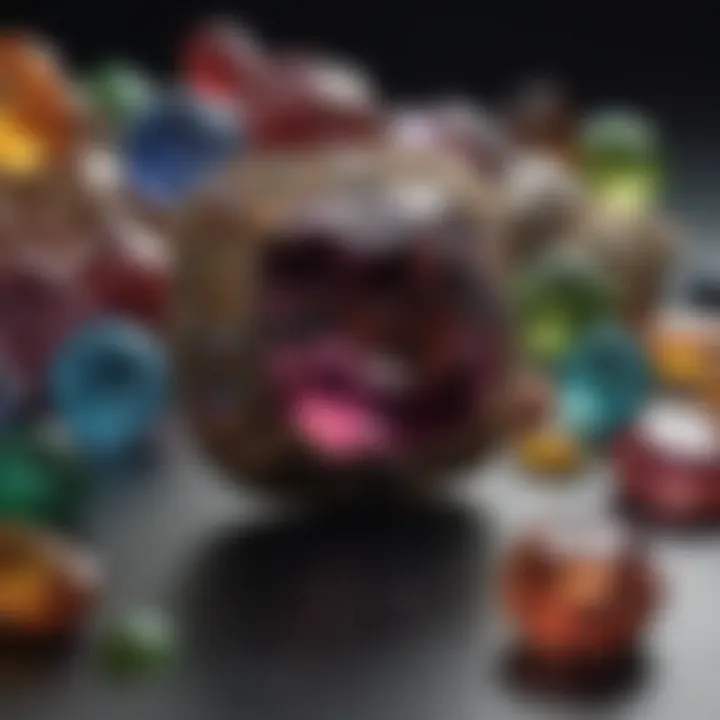
The Hebrew Bible and Sacred Stones
The Hebrew Bible offers a distinctive viewpoint on birthstones, highlighting their spiritual importance. The Book of Exodus describes the breastplate of Aaron, which carried twelve stones, each representing one of the tribes of Israel. This design stressed identity and community among the tribes, reinforcing how vital gemstones were in religious practices.
These sacred stones were believed to symbolize moral values, strength, and divine protection. Many scholars argue that this ancient representation signifies a profound connection between personal identity and sacred stones, which influences how birthstones are perceived in various cultures today.
The Influence of the Ancient Romans
The Romans have profoundly shaped the history of birthstones, contributing to their associations and significance in ways that resonate even today. In ancient Rome, gemstones were more than decorative items; they were imbued with symbolic meanings and believed to possess certain powers. This period saw the birth of the notion of assigning specific stones to each month of the year, laying the groundwork for the modern birthstone list.
Gemstone Association with Zodiac Signs
The ancient Romans were keen observers of the celestial bodies and their movements. They connected the influence of the zodiac with particular gemstones, creating a system where birthstones were aligned with astrological signs. Each zodiac sign was associated with certain energies and traits, and the corresponding gemstones were thought to amplify these qualities. For instance, Aries was linked with diamonds, known for their brilliance and strength, while Taurus favored emeralds, symbolizing fertility and harmony.
- Aries: Diamond
- Taurus: Emerald
- Gemini: Pearl
- Cancer: Ruby
- Leo: Peridot
This alignment of gemstones with zodiac signs offered individuals a personal talisman of sorts, thought to enhance their unique characteristics and mitigate challenges. Many Romans used these stones in jewelry and amulets, believing they provided protection and courage in various aspects of life.
Birthstones in Roman Society
In Roman society, gemstones were not only markers of wealth but also of status and influence. High-ranking individuals often adorned themselves with intricate jewelry that incorporated birthstones, showcasing their connection to both their identity and their astrological profile. Common citizens, too, valued these stones, as they were believed to hold healing properties or luck. Many Romans wore gemstones as charms or talismans to ward off misfortune.
The popularity of birthstones during this era also led to the craftsmanship of elaborate settings that highlighted the beauty of the stones. Artisans developed new techniques in jewelry making, blending functionality with artistry.
"Gemstones served as both symbols of personal identity and conduits of divine favor in Roman culture."
As Romans traveled and traded, they disseminated their views on gemstones and birthstones across their empire, blending local beliefs with their own. This exchange enriched the tapestry of birthstone lore, which continued to evolve over centuries.
Understanding the influence of ancient Rome on birthstones is crucial in recognizing how these traditions developed. The patterns established during this time persist in the way modern cultures perceive and utilize birthstones, maintaining a lasting legacy in jewelry and personal symbolism.
The Middle Ages and Birthstones
The Middle Ages marked a significant evolution in the significance and perception of birthstones. In an era rife with tumult, the turbulent interplay between religion and material culture transformed gemstones from mere decorative items to objects of profound symbolic meaning. Birthstones during this time were often believed to possess mystical properties and were associated with various Christian traditions. This connection to Christian symbolism gave gemstones an important role beyond just aesthetics; they were seen as channels for divine favor and protection.
Christian Symbolism and Gemstone Lore
The resonance of Christianity in medieval society deeply influenced how gemstones were viewed. Early Christian teachings associated certain stones with specific spiritual virtues or biblical references. This established a tradition of attributing deeper significance to particular gemstones, often linked with the twelve tribes of Israel, as mentioned in the Book of Exodus.
"The foundation of the wall of the city was adorned with every kind of jewel" - Revelation 21:19.
Today, many still see these Biblical references as important in considering the historical context of birthstones. Each gem embodies distinct characteristics; for instance, amethyst was linked to clarity of mind and spiritual wisdom, while sapphires were believed to offer divine protection.
The practice of wearing a specific gemstone associated with one's birth month gained traction during the Middle Ages. It was believed that wearing the corresponding stone would confer its powers and blessings upon the individual. Additionally, gemstones began to serve as protective talismans against various misfortunes. Many people adorned themselves with jewelry not just for beauty, but for its presumed ability to shield from negative energies or influence.
Birthstones in Medieval Jewelry
Jewelry in the Middle Ages became a significant form of personal expression and status. Birthstones were integrated into various jewelry pieces, from rings to brooches, making them appealing for both their decorative and protective qualities.
Medieval jewelers often incorporated birthstones into intricate designs, reflecting the artistry of the time. For instance, elaborate gold work embellished with precious stones was prevalent among the aristocracy. The significance of birthstones extended into royal courts, serving as symbols of power, wealth, and protection from harm.
In addition to rings, gemstone-embedded rosaries became a common possession. Here, gemstones represented not only personal attributes but also served as tools for prayer and meditation, further intertwining their fate with spiritual practices of the time.
Jewelry became a reflection of individual identity, with birthstones at the heart. Thus, these stones transformed from primitive beliefs to essential symbols of societal hierarchy, personal introspection, and spiritual belief, shaping how they are perceived in later centuries.
In summary, during the Middle Ages, birthstones evolved into powerful symbols intertwined with Christian beliefs, significantly influencing both personal adornment and social status. The profound and layered heritage of these stones laid the groundwork for their lasting appeal throughout history.
The Modern Era and Birthstones
In the context of our ongoing exploration of birthstones, the modern era represents a significant transformation in their perception and use. Birthstones have evolved from sacred symbols of ancient cultures to personal talismans and fashionable elements in contemporary jewelry. The resurgence in interest toward personalized jewelry has breathed new life into the traditions associated with these stones. As more individuals seek meaningful gifts and distinctive means of self-expression, birthstones have found a definitive place in modern society.
The Birthstone List of the 20th Century
In the early part of the 20th century, the establishment of a standardized birthstone list emerged as a pivotal moment for the gem industry and consumers alike. The American National Retail Jewelers Association, now known as the American Gem Society, published an official list in 1912. This was an effort to create consistency and clarity regarding which gemstones corresponded to each month. The list consisted of the following stones:
- January: Garnet
- February: Amethyst
- March: Aquamarine
- April: Diamond
- May: Emerald
- June: Pearl
- July: Ruby
- August: Peridot
- September: Sapphire
- October: Opal
- November: Topaz
- December: Turquoise
This standardized list has largely persisted even into the 21st century, with minor adjustments reflecting changing tastes and gem availability. By promoting certain gems as traditional birthstones, retailers have enabled consumers to view these stones not just as decorations but as part of personal identity.
Contemporary Practices and Trends
Current trends emphasize personalization, with many consumers choosing to customize their jewelry to reflect their personal stories and styles. Birthstones now serve various purposes beyond mere adornment. Many people select birthstones for engagement rings, necklaces, or family jewelry, as they symbolize important moments in life.
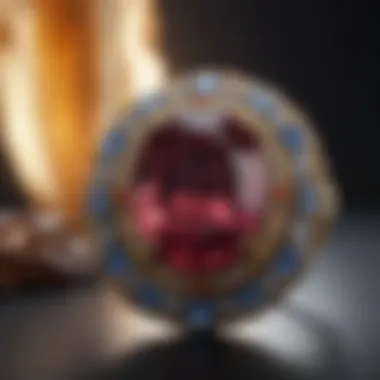
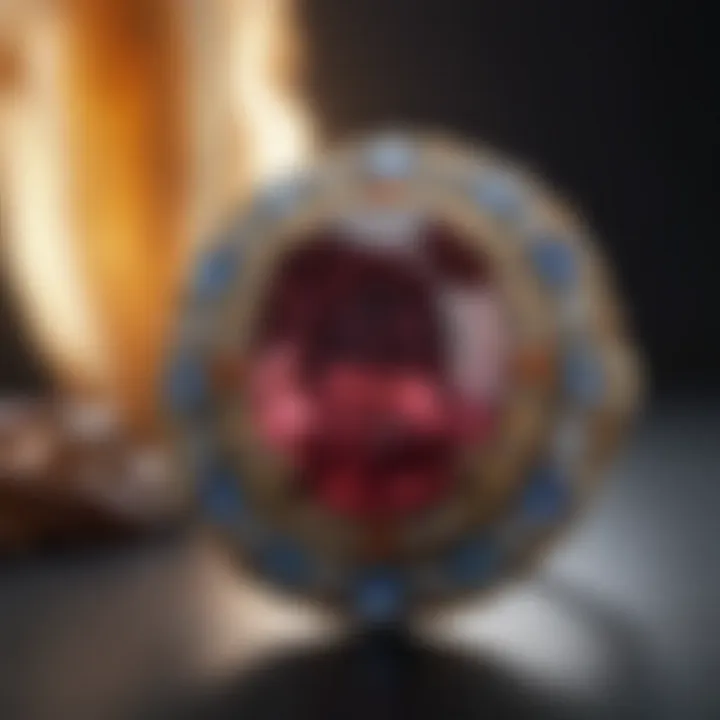
Additionally, there is a noticeable trend toward ethically sourced stones. Many consumers are becoming conscious of the origins of their jewelry, leading them to prefer stones that are conflict-free or lab-created. The modern generation is increasingly looking for ways in which their choices align with their values, making it essential for jewelers to adapt.
Moreover, birthstones are integrated into conceptions of well-being. It is common to find claims regarding the healing and protective properties of these stones circulating in social media and among gemstone enthusiasts. This modern mythos surrounding birthstones forms a new layer of significance, linking personal beliefs with tangible symbols.
"In contemporary society, birthstones embody a fusion of tradition and individuality, offering not only aesthetic value but emotional and symbolic significance as well."
To sum up, the modern era has redefined birthstones to accommodate a variety of needs and desires. Whether it's an expectation for personalized gifts, a concern for ethical sourcing, or a belief in the metaphysical properties of stones, the modern age has certainly enhanced the discourse surrounding birthstones.
Cultural Variations of Birthstones
Understanding cultural variations of birthstones reveals how different societies interpret and use these gemstones. This section highlights the global diversity in birthstone associations, enriching our knowledge and appreciation of this fascinating topic. By examining how various cultures embrace specific stones, we can gain a deeper insight into their meanings and values. This understanding can enhance personal connections to birthstones, making them more than mere jewelry but symbols of cultural heritage and personal identity.
Birthstones in Different Cultures
The practice of assigning a particular gemstone to each month varies widely across cultures, leading to unique interpretations and values of these stones. For instance, in Western traditions, January is represented by garnet, signifying loyalty and truth. Meanwhile, in Indian culture, the significance of gemstones is more extensive, with specific stones believed to bring good fortune, health, or protection against evil spirits.
- In Hindu traditions, gemstones are classified by the nine planetary deities.
- Each planet has a designated stone, such as ruby for the Sun and diamond for Venus.
- These stones are not just decorative; they are seen as tools for spiritual alignment and personal well-being.
In Chinese culture, various meanings are assigned to stones based on traditional beliefs. For example, jade is prominent, symbolizing purity and moral integrity. It holds a revered place in Chinese history and is integrated within familial relationships and social status. Moreover, the notion of the Five Elements—wood, fire, earth, metal, and water—further influences which stones are favored at specific times.
These variations showcase how birthstones serve more than an aesthetic purpose—they encapsulate a society's history, beliefs, and customs. Individuals may want to choose stones based on their cultural significance rather than just the corresponding month. This choice may lead to a more profound connection to the stone's meaning.
The Zodiac Influence in Various Traditions
The Zodiac plays a crucial role in assigning gemstones across different traditions. While Western astrology uses twelve signs, each associated with specific gemstones, other cultural practices may have unique methods or associations.
In Western traditions:
- Aries is linked to diamond.
- Taurus connects with emerald.
- Gemini associates with pearl.
Conversely, Vedic astrology in India also employs a zodiac system but integrates planetary influences more extensively. Each sign is connected to specific birthstones that can guide individuals toward favorable outcomes. This practice relies on the belief that celestial bodies at the time of someone's birth influence their life path, character traits, and fortunes.
For example:
- Scorpio connects with aquamarine, believed to enhance emotional clarity.
- Leo is matched with ruby, symbolizing courage and leadership.
The differences in zodiac influences demonstrate the rich tapestry of beliefs surrounding birthstones. They provide various opportunities for adornment purposes while also inviting wearers to explore their birth's astrological significance.
The study of cultural variations in birthstones educates individuals about the diverse ways gems are valued and integrated into a society's heritage.
These insights can enrich the experience of wearing or gifting birthstones, allowing people to connect more profoundly with their personal histories and cultural legacies.
The Role of Birthstones in Modern Jewelry
Birthstones hold significant importance in contemporary jewelry design and personal expression. They are not only beautiful stones but also carry deep meanings that resonate with the wearer. Birthstones serve as a means to connect individuals to their birth month, personal identity, and cultural background. Jewelry designers often integrate these stones into their works to create unique, meaningful pieces that appeal to a broad audience.
Design and Craftsmanship
The craftsmanship involved in creating birthstone jewelry is intricate and varied. Designers employ a myriad of techniques to highlight the natural beauty of each gemstone. Often, the choice of metal settings—be it gold, silver, or platinum—complements the birthstone, enhancing its color and brilliance.
Considerations in design include:
- Cut: The shape and style of the cut can amplify the lights that reflect through the stone. Popular cuts like Princess, Round, and Emerald are often utilized based on the stone's characteristics.
- Setting: The manner in which the stone is set plays a crucial role. Common techniques include prong, bezel, and channel settings, which all function to secure the stone while showcasing its beauty.
- Overall Aesthetic: Designers blend various styles, from classic to contemporary, ensuring that the final piece suits the preferences of potential buyers. By considering current trends while respecting traditional values, craftsmen create pieces that resonate with both historical significance and modern flair.
Customization of Birthstone Jewelry
Customization of birthstone jewelry has become a popular trend among consumers, allowing for personal expression and individual narrative.
When commissioning a piece, clients often consider:
- Personalization: Engraving names, dates, or special messages onto the jewelry adds an intimate touch. This transforms a standard piece into a cherished memory.
- Combination of Birthstones: Some opt for designs that incorporate the birthstones of family members. This reflects connections to loved ones, enhancing the emotional value of the piece.
- Design Alterations: Many jewelers offer alterations in the design to meet specific tastes, such as adjusting the number of stones or changing the type of metal.
Customizing birthstone jewelry allows individuals to create a wearable representation of their life stories, turning a simple ornament into a significant symbol.
Through customization, birthstones transcend their decorative role, becoming vital parts of personal history and identity. This trend illustrates the evolving relationship individuals have with jewelry, making it more than just an accessory—it's a reflection of one's unique narrative.
Understanding the Symbolism of Birthstones
The concept of birthstones is deeply rooted in tradition and cultural beliefs. Each stone is thought to carry specific meanings and attributes, making its symbolism crucial in the context of personal identity and cultural practices. Birthstones can evoke deep emotional connections, often representing the qualities and characteristics associated with the month of birth. This personalization helps individuals to feel a sense of belonging and significance when wearing their birthstone. In many cultures, these stones are more than mere objects of beauty; they are considered guides and talismans holding profound spiritual significance.
In this article, we will explore how understanding the symbolism of birthstones can enhance their value in jewelry design, collecting, and gifting. Knowledge about the stones can inform choices in personal adornment as well as influence the emotional resonance of gifts.
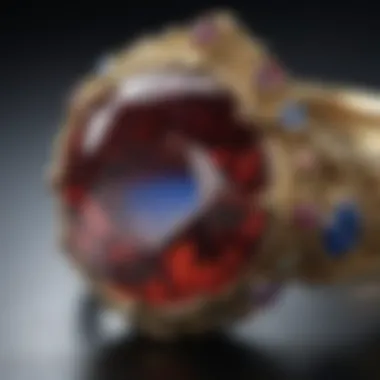
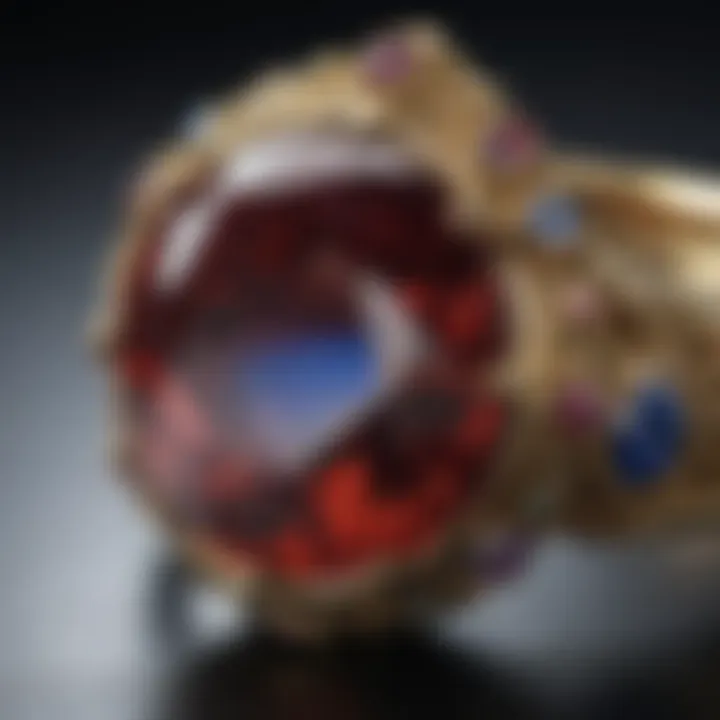
Personal Association and Meaning
Personal stories intertwine with the meanings of birthstones. For many people, a birthstone symbolizes more than just a gemstone; it represents their journey and identity. Each individual can feel a connection to their birthstone, which may resonate with personal characteristics or experiences.
For instance, January's garnet is often associated with strength and protection, making it a meaningful a choice for those born in this month. Meanwhile, April's diamond, emblematic of purity, love, and commitment, tends to be chosen for significant life events, such as engagements and weddings.
This association between stones and personal narratives gives depth to the jewelry, creating a unique bond between wearer and piece. In essence, birthstones can serve as a reflection of one's personality and life's path, transforming them from simple adornments into cherished keepsakes.
Metaphysical Properties Attributed to Birthstones
The metaphysical properties of birthstones have been a subject of exploration for many cultures and traditions through the ages. Different gemstones have been ascribed various energies that can promote wellbeing and healing. Enthusiasts believe that wearing a birthstone can enhance personal attributes and provide beneficial effects.
For example:
- Amethyst (February): Thought to increase intuition and relieve stress.
- Emerald (May): Believed to foster love and harmony.
- Sapphire (September): Associated with wisdom and protection.
These metaphysical qualities contribute not only to the allure of birthstones but also their functional role in a person's life. This holistic connection within the context of crystal healing and personal development adds another layer of significance to birthstones, further enriching the experience of those who embrace them.
"Birthstones are more than just pretty gems; they are powerful symbols of identity and transformation."
As we delve deeper into the implications of these gems, it becomes clear that their meanings are not just products of lore, but a tapestry of cultural narratives that offer insight into human experience.
Mythology and Folklore Related to Birthstones
The intertwining of mythology and folklore with birthstones reflects a deep cultural significance that transcends individual societies. Birthstones are often more than just colorful gemstones; they are steeped in beliefs that give them distinct powers and meanings. Various cultures have connected precious stones with their deities, creation myths, and healing practices, reinforcing their role in rituals and personal identity. Understanding these aspects enriches the appreciation of birthstones, enabling individuals to connect emotionally with these gems.
Legends of Gemstones in Various Cultures
In many ancient civilizations, gemstones were believed to possess unique properties that served both practical and spiritual purposes. For example, the ancient Greeks associated amethyst with Bacchus, the god of wine. This stone was thought to prevent intoxication and promote clarity of thought. Similarly, in Indian culture, diamonds were revered and linked to the planet Venus, embodying love and virtue. The belief that these stones could influence human behavior solidified their presence in rituals focusing on love, prosperity, and protection.
"Each birthstone carries a legacy of symbolism that connects us to our ancestors' beliefs and practices."
In contrast, the Māori of New Zealand regarded certain stones, like pounamu (greenstone), as sacred. For them, these stones represented the life force of the landscape and were often used in rituals and as heirlooms, embodying family history and identity. Such beliefs illustrate how different cultures attribute not only aesthetic value but also spiritual significance to gemstones, often passed down through generations.
Folklore Beliefs Surrounding Birthstones
Folklore surrounding birthstones is abundant, emphasizing their role in daily life and personal destiny. Many traditions claim specific stones can offer protection or good fortune to the wearer. The tradition of wearing a birthstone often begins at birth, with the belief that such stones can influence personality traits and health. For example, those born in July might wear rubies, associated with vitality and courage.
The folkloric view of birthstones includes various practices. In some cultures, it is customary to wear one's birthstone during significant life events like marriages and baptisms. These occasions serve as reminders of the wearer's birth month and its associated qualities, reinforcing personal connections to identity and legacy. Some beliefs suggest that failing to wear one's birthstone can lead to bad luck, presenting an unseen bond between the individual and the gemstone.
The modern interpretation of folklore surrounding birthstones often combines these ancient beliefs with contemporary practices, leading to the personalization of jewelry and its significance. Whether through birthstone jewelry or casual gifting, these stones continue to serve not just as markers of identity but as vessels of ancient beliefs infused with modern meanings.
Birthstones as Gifts
The significance of birthstones as gifts is an essential theme in understanding their cultural and emotional value. These gemstones are often associated with personal attributes and characteristics linked to a particular month or zodiac sign. When given as a gift, a birthstone conveys more than just aesthetic appeal; it embodies a message, a sentiment, or a deep connection to the recipient. Each birthstone carries its own lore, history, and emotional undertones, making it a thoughtful choice for various occasions.
Choosing the Right Birthstone for Occasions
When selecting a birthstone as a gift, it is crucial to consider both the occasion and the recipient’s personal preferences. Here are some elements that can help guide the decision:
- Recipient’s Birth Month: The most straightforward method is to choose the stone corresponding to the month of the recipient's birth. For example, if they were born in July, a ruby can be a suitable choice.
- Personal Style: Some individuals prefer minimalist designs while others appreciate bold statements. Knowing the recipient’s taste can inform the choice of gemstone and jewelry design.
- Symbolic Meaning: Many birthstones have specific meanings or metaphysical properties. For instance, amethyst, the birthstone for February, is often associated with calmness and clarity. This may appeal to someone who values tranquility in their life.
- Occasion Type: Birthstones fit various occasions. Whether it’s for birthdays, anniversaries, or graduations, the context can dictate the choice of the stone, making it more meaningful.
Emotional Significance of Birthstone Gifts
Birthstone gifts carry deep emotional significance. They are not purely decorative objects; they symbolize connections and personal relationships.
- Personal Associations: A birthstone can evoke memories or feelings associated with a particular time or place. It’s like carrying a piece of one's history, adding a layer of sentiment to the gift.
- Connection to Family Heritage: Birthstones can reflect family ties and legacy. For example, a grandparent might gift a birthstone piece to their grandchild, symbolizing continuity and connection across generations.
- Message of Care: Giving a birthstone as a gift demonstrates thoughtfulness. It shows that the giver has considered the recipient’s individuality and shared a part of their essence through the chosen stone.
"A birthstone is more than just a gem; it’s a representation of life’s journeys and emotional bonds."
Finale: The Lasting Legacy of Birthstones
The study of birthstones offers a reflection on human culture, values, and emotions. This article emphasizes that the legacy of birthstones is not only about their aesthetic value but also about the deeper meanings they hold throughout history. Birthstones carry with them a rich tapestry of symbolism passed through generations. Their significance transcends mere ornamentation — they connect individuals to their roots, family, and cultural heritage.
In this exploration, we witnessed the evolution of birthstone traditions from ancient civilizations to contemporary practices. The historical context provided insight into how cultural beliefs shaped the values associated with different stones. Each gem encapsulates unique stories and legends, making them more than just identifiers for months but conduits of connection and identity.
From the mythological tales to the modern-day preferences, the role of birthstones has evolved while remaining relevant. Their emotional significance is a key consideration, especially when selected as gifts for special occasions. The choice of a birthstone goes beyond aesthetics; it embodies sentiments such as love, connection, and legacy.
Benefits of Understanding Birthstones:
- Cultural Connection: Learning about the characteristics and histories of various stones can enhance appreciation and foster a sense of belonging.
- Personal Significance: Selecting a birthstone based on personal connections can meaningful to individual identity and offer comfort.
- Investment Value: Unique or rare birthstones can also hold monetary value, adding another layer of importance.
Considerations Around Birthstones:
- Trends: Awareness of trends in birthstone jewelry allows for more personalized selections.
- Sourcing: The origin of gemstones can also affect their meanings and value.
- Sustainability: Ethical considerations should be taken into account when purchasing birthstones.
Ultimately, birthstones are imbued with enduring appeal across generations. They bridge the past and present and serve as a reminder of personal milestones and shared histories. The intricate narrative of birthstones weaves into the fabric of our lives, making them timeless treasures of significant worth.



